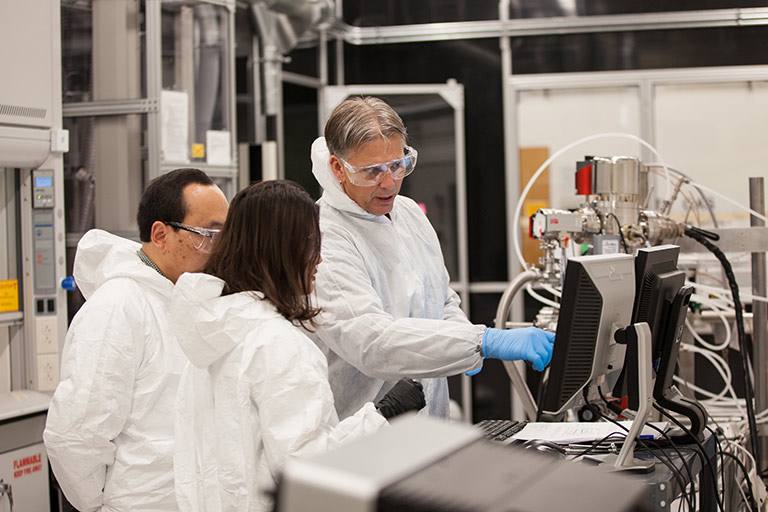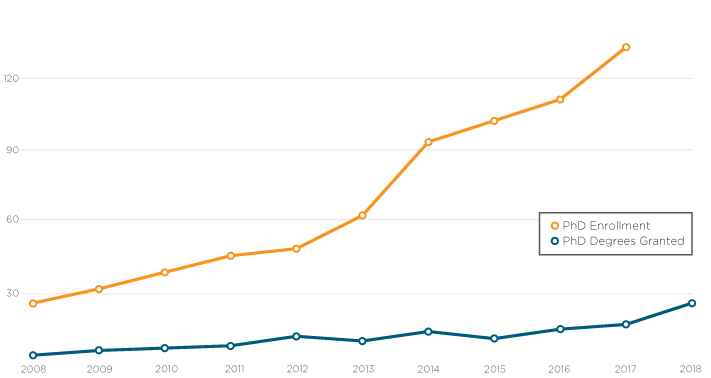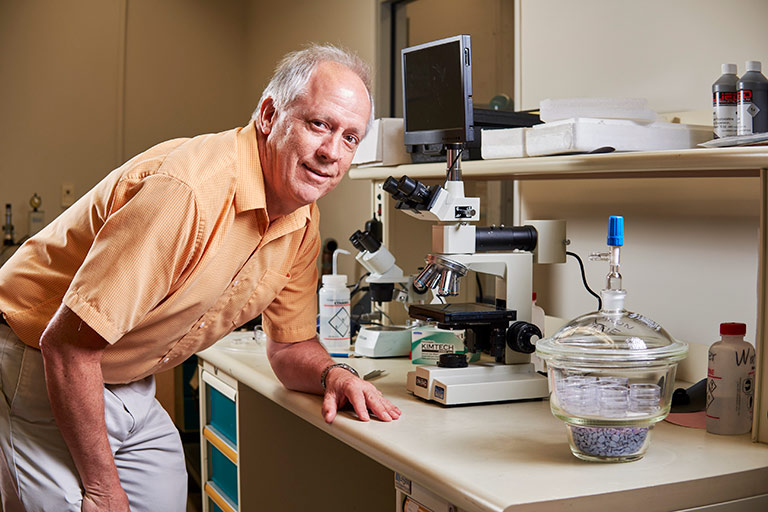
In 2018, the Department of Nuclear Engineering graduated 24 doctoral students—a record number for any nuclear engineering program in the United States. Ever.
But success like that doesn’t just happen overnight. It was the result of foresight, planning, growth, and making careful considerations over a period of years to create the most well-rounded and high-value program possible.
Recognizing a Problem
In 2007, the department had seven faculty members. By the time Wes Hines became department head in 2012, there were 12. He knew if the department were to reach its goal of making more significant scholarly contributions to the field, that number would have to grow even higher.
By 2014, the department had grown to 17 tenured or tenure-track faculty members. The department also houses five full-time research faculty and two joint UT-Oak Ridge National Laboratory Governor’s Chairs: Brian Wirth (pictured above) for computational nuclear engineering and Steven Zinkle (pictured below) for nuclear materials.
“Expanding the faculty like we did has allowed us to engage in new research areas that we weren’t able to before, notably nuclear materials and nuclear security,” Hines said. “It also increased activity across the board, gave our faculty a chance to be more engaged with students, and significantly ramped up our overall research portfolio.”
The department was now on the move.
Shifting the Focus
Another key moment in the department’s upward trajectory was its decision to position its research focus on tackling some of the nation’s biggest challenges.
But in order to handle those new opportunities, the department first had to increase enrollment, particularly among doctoral students.
In 2008, doctoral students were just one-third of the department’s graduate enrollment, but have since risen to around 85 percent. Since 2012, the number of doctoral students has increased from 47 to 132.

“Doctoral students take four to six years to graduate as opposed to the one or two years needed for a Masters,” Hines said. “That’s important, because as the percentage of doctoral students increases, so too does the average time we have students and it takes several years to make research contributions that can impact national needs.”
It has also increased the department’s importance to the regional economy. Chances for professional development abound in the area, which has the largest concentration of nuclear industry anywhere in the world.
Students now had opportunity, both scholastically and post-graduation.

Research
While the department has always had an outpouring of research, the importance and value of its work to the world around has increased as steadily as the faculty
and enrollment.
“Hiring Governor’s Chairs in Nuclear Security and Nuclear Materials aligned us with important national research needs,” said Hines. “These top faculty not only solidified our relationships with local research partners in Y-12 and ORNL; they also changed our research culture. We focused on larger, more impactful research topics and funding opportunities.”
The department has taken a leading role in nuclear materials, in particular.
Materials Science and Engineering’s William Weber, the joint UT-Oak Ridge National Laboratory Governor’s Chair for Radiation Effects on Materials, has several projects that are in line with the department’s work, while the UT-ORNL Joint Institute for Advanced Materials further strengthens the department’s work and collaboration in
nuclear materials.
Nuclear security is another area of global importance that, as Hines hoped, has grown into an area of strength for UT. The US Department of Homeland Security has
turned to the department multiple times for expertise, including supporting:
- Laurence F. Miller (now Professor Emeritus) and his work developing neutron detectors;
- Jason Hayward and a colleague in the Min H. Kao Department of Electrical Engineering and Computer Science who have developed a portable radiation detection device;
- Eric Lukosi and colleagues from the Department of Materials Science and Engineering who are working on low-cost scintillators for radiation detection.
In addition, faculty have given talks and received awards at the highest levels of national and international agencies, students have increasingly won US Department of Energy Scholarships and Fellowships through the Nuclear Energy University Program, and national recognition from peers has solidified the department as a consistently top-ranked program.
UT’s proximity to ORNL and the Y-12 Nuclear Security Complex has also helped attract top minds and talent to both the faculty and student body, thanks to joint faculty positions and research projects being conducted at facilities such as ORNL’s Spallation Neutron Source.
“Scholarship, research funding, faculty, students; all of those things are tied into one another,” Hines said. “It’s hard to be successful as a department or in any of those areas without the other three also being solid.”
The foundation was set.
Setting the Bar
The class of doctoral students who set the record for the largest nuclear engineering class in US history didn’t come to UT with that goal in mind.
They didn’t come because of $129 million building that is finally under construction.
They didn’t come on a whim.
They came because the department is energized by a stellar faculty with big ideas who are conducting meaningful research in one of the country’s top places to be studying nuclear engineering.
It started with a plan that was laid before they finished their undergraduate work, was followed through in detail, and has now come to fruition.
“We didn’t set out to have the largest class of doctorates, or even really with any other goal in mind,” Hines said. “We just wanted to be the best we could be, the best we knew we had the potential to be. Our goal was just to be our best.”
At spring commencement, they were just that: the best. Ever.